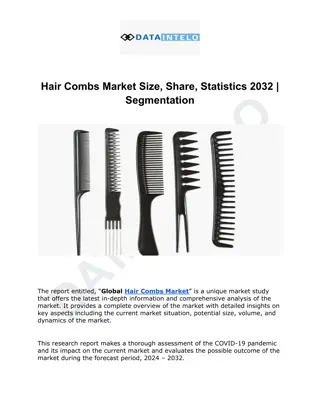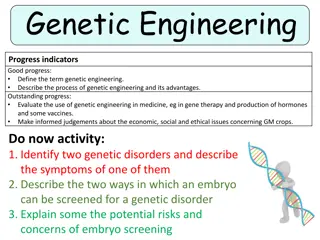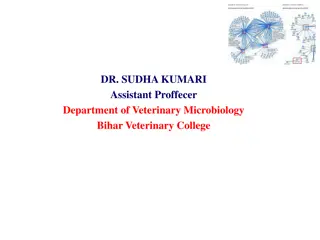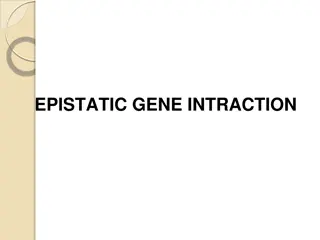Genetic Interactions in Chicken Combs: Epistatic and Non-Epistatic Examples
In chicken genetics, epistatic and non-epistatic interactions play a crucial role in determining comb size and shape. Bateson and Punnett's studies on fowls revealed how different gene pairs interact to produce distinctive phenotypes. Epistatic interactions, such as dominant epistasis, influence the expression of alleles and result in specific F2 ratios. Understanding these genetic interactions provides insights into the complexity of inheritance patterns in chicken combs.
Download Presentation

Please find below an Image/Link to download the presentation.
The content on the website is provided AS IS for your information and personal use only. It may not be sold, licensed, or shared on other websites without obtaining consent from the author. Download presentation by click this link. If you encounter any issues during the download, it is possible that the publisher has removed the file from their server.
E N D
Presentation Transcript
genetic course lecture (9) Epistatic interaction Dr. israa hussein hamzah email: esraa_hassan17@yahoo.com szsh@uomustansiriyah.edu.iq Reference book: genetic (Conceptual- Approach) fourth edition (2012) Author: Benjamin C. Pierce
NON-EPISTATIC INTER-ALLELIC GENETIC INTERACTIONS In certain cases, two pairs of genes determine a same phenotype but assorted independently, produce new phenotypes by mutual non-epistatic interactions and the F2 phenotypic ratio 9 : 3 : 3 : 1 remains unaltered. Two pairs of genes which interact to affect size and shape of comb but are independently transmitted exist in chicken. Example: Combs in fowl (9 : 3 : 3 : 1). The classical case of genetic interaction of two genes is discovered by Bateson and Punnett (1905 1908) in fowls. There are many different breeds of domestic chicken. Each breed possesses a characteristic type of comb. The Wyandotte breed has a comb called rose , the Brahmas breed has a comb called pea , and the Leghorns have a comb called single . Each of these types can be bred true. A cross of chicken with a rose comb to one with a single comb produces rose and single, showing dominance of rose over single. Another cross between pea combed and single combed chickens produces pea and single combed chickens in the ratio of 3 : 1, showing dominance of pea oversingle. But, when a rose combed chicken crossed with that of pea combed, the F1 progeny was found with a different type of comb known as walnut (Malay breed). When the F1 walnut combed chickens were bred together, in F2 all four types of combs, i.e., 9/16 walnut, 3/16 rose, 3/16 pea and 1/16 single appeared .
These peculiar results were interpreted by Bateson and Punnett as follows : The rose comb is caused by the combination of homozygous recessive genes pp and homozygous or heterozygous dominant genes RR or Rr . The pea comb is supposed to be produced by combination of a homozygous recessive condition (rr) and homozygous or heterozygous dominant condition (PP or Pp). While, the single type comb is produced by the double recessive, rrpp, genes. Thus, R gene determines the shape of rose comb and P gene determines the shape of pea comb, but when both genes happen to come together in single individual due to cross between rose and pea combed chickens, they interact to produce a walnut comb in F1. In the cross of two walnut chickens, two genes interact variously and produces four types of offsprings in F2. Thus, here two pairs of genes interact to produce comb size and shape in fowl. During the inheritance of combs in fowls, the genes themselves do not determine the development of a character(presence or absence of comb) and simply modify a character determined by a basic gene and, therefore, known as supplementary or modifying genes.
KINDS OF EPISTATIC INTERACTION When in dihybrid crosses, the epistatic interactions occur between two genes, less than four phenotypes appear in F2. Such bigenic (two gene) epistatic interactions may be of following six types: 1. Dominant Epistasis (12: 3 : 1) When out of two genes, the dominant allele (e.g., A) of one gene masked the activity of alleles of another gene (e.g., B) and expressed itself phenotypically, then A gene locus is said to be epistatic to the B gene locus. Because, the dominant allele A can express itself only in the presence of either B or b allele, therefore, such type of epistasis is termed as dominant epistasis. The alleles of hypostatic locus or gene B will be able to express themselves phenotypically only when gene locus A may contain two recessive alleles (aa). Thus, the genotype AA BB or Aa Bb and AA bb or Aa bb produce the same phenotype whereas the genotype aa BB or aa Bb and aa bb produce two additional phenotypes. The dominant epistasis modify the classical ratio of 9: 3: 3: 1 into 12: 3: 1 ratio.
Example Dominant epistatis in dogs. Among dogs, the colours of coats depend upon the action of two genes. One gene locus has a dominant epistatic inhibitor allele (I) of coat colour pigment . The allele I prevents the expression of colour allele at another independently assorting, hypostatic gene locus (B or b) and produces white coat colour. The alleles of hypostatic gene locus (BB, Bb, or bb) express only when two recessive alleles (ii) occur on the epistatic locus, i.e., ii BB or ii Bb produces black and ii bb produces brown individuals. When two such white coat colour dogs are crossed, in F1 the white, black and brown coat colours appear in 12 : 3 : 1 ratio.
2. Recessive Epistasis (9 : 3 : 4) Sometimes the recessive alleles of one gene locus (aa) mask the action (phenotypic expression) of alleles of another gene locus (BB, Bb or bb alleles). This type of epistasis is called recessive epistasis. The alleles of B locus express themselves only when epistatic locus has dominant alleles (e.g., AA or Aa). Due to recessive epistasis the phenotypic ratio 9: 3: 3: 1 becomes modified into 9: 3: 4 ratio. Example Recessive epistasis in mice. In mice various types of epistatic genetic interactions have been reported. The most interesting case is of recessive epistasis in coat colours. The common house mouse occurs in a number of coat colours, i.e., agouti, black and albino. The agouti colour pattern is commonly occurred one (wild type) and is characterized by colour banded hairs in which the part nearest the skin is gray, then a yellow band and finally the distal part is either black or brown. The albino mouse lacks totally in pigments and has white hairs and pink eyes.
3. Duplicate Genes with Cumulative Effect (9: 6: 1) Certain phenotypic traits (e.g., coat colouration) depend on the dominant alleles of two gene loci. When the dominant condition (homozygous or heterozygous) at either locus (but not both) produces the same phenotype, the F2 ratio becomes 9: 6: 1. Example Cumulative effect in coat colour of pigs. In the Duroc-jersey breed of pigs, coat colour is influenced by two pairs of genes that interact in peculiar manner . Sandy coat colour results from a dominant gene S, and the homozygous recessive (ss) is white in colour. Sandy coat colour may also result from a non- allelic dominant gene R; its homozygous recessive (rr) is also white
. When a sandy pig (SS rr) is crossed with a second sandy pig (ss RR), the F1 offsprings were found with red coloured coats. Such interactions are said to be the result of mutually supplementary genes. When F1 red coated pigs cross bred among themselves they produce red, sandy and white coats in the ratio of 9 : 6 : 1 . 4. Duplicate Recessive Genes (or Complimentary genes) (9: 7) If both gene loci have homozygous recessive alleles and both of them produce identical phenotypes, the F2 ratio 9: 3: 3: 1 would become 9: 7. In such case, the genotypes aa BB, aa Bb, AA bb, Aa bb, and aa bb produce one phenotype (Table 4-7). Both dominant alleles when present together, complement each other and are called complementary genes and produce a different phenotype. A case of such complemental inheritance, resulting from the combined action of complemental genes is known in sweet peas.
Example When a pure line variety of white flowered sweet pea (Lathyrus odoratus) was crossed with another pure line variety of white flowered sweet pea, in F1 purple or red flowered plants were produced .The F1 plants when self-pollinated or crossed among themselves, produced the F2 generation with the phenotypic ratio of 9 coloured and 7 white flowered plants. Epistatic alleles Hypostatic alleles Phenotypic expression of allele F2 Phenotypic ratio 1. cc EE, Ee, ee Neither c nor E or e 2. CC, Cc ee Neither C or c nor e 3. CC, Cc EE, Ee Both C+E (complementation)* Coloured=9
* Chromogen production due to complementation of C and E (i.e., dominant epistatic and hypostatic alleles). These surprising results could be understood by analysing the mechanism of colour production in flowers. A given enzyme (genetically controlled as to absence or presence in a given individual) acts upon chromogen (a colourless colour base whose absence or presence is also genetically controlled) to produce the purple or red colour of flowers. The dominant allele or alleles (CC or Cc) of gene C are responsible for the presence of chromogen, while the homozygous recessive alleles (cc) of this gene are responsible for the absence of chromogen. Likewise, the dominant alleles of gene E in homozygous (EE) or heterozygous (Ee) conditions caused the production of an enzyme which is necessary for colour production from chromogen, while homozygous recessive (ee) condition does not produce any such enzyme.
The appearance of 9: 7 ratio instead of 9: 3: 3: 1 ratio from the cross of two white flowered sweet pea plants (CC ee X cc EE) can be illustrated as follows: P: White flowers X White flower CC ee cc EE P gametes: (Ce) (cE) F1: Purple flower X Purple flower Cc Ee CcEe F1 Male gametes: F1 Female gametes:
CE Ce cE ce CE CCEE CCEe CcEE CEce Purple Purple Purple Purple Ce CCEe CCee CcEe Ccee Purple White Purple White cE CcEE CcEe ccEE ccEe Purple Purple Whlite White ce CcEe CcEe ccEe ccee Purple White White White F2 phenotypic ratio : 9/16 purple : 7/16 white or 9 : 7.
5. Duplicate Dominant Genes (15: 1) If the dominant alleles of both gene loci produce the same phenotype without cumulative effect, the 9: 3 : 3 : 1 ratio is modified into a 15 : 1 ratio . Example The seed capsules of shepherd s purse (genus Capsella) occur in two different shapes, i.e., triangular and top-shaped. When a plant with triangular seed capsule is crossed with one having top-shaped capsule, in F1 only triangular, character appears. The F1 offsprings by self-crossing produce the F2 generation with the triangular and top-shaped seed capsules in the ratio of 15: 1. Two independently segregating dominant genes (A and B) have been found to influence the shape of the capsule in the same way. All genotypes having dominant alleles of both of these genes (A and B) would produce plants with triangular-shaped capsules. Only those with the genotype aa bb would produce plants with top-shaped capsules
6. Dominant and Recessive Interactions (13: 3) Sometimes, the dominant alleles of one gene locus (A) in homozygous (AA) and heterozygous (Aa) condition and the homozygous recessive alleles (bb) of another gene locus (B) produce the same phenotype, the F2 phenotypic ratio becomes 13: 3 instead of 9: 3 : 3 : 1. In such case, the genotype AA BB, AABb, Aa BB, Aa Bb, AA bb and Aa bb produce same phenotype and the genotype aa BB, aa Bb and aa bb produce another but same phenotype. Example In Leghorn type of fowl the white colour of feather is aused by the dominant genotype CC II, similarly the white colour of feathers of Plymouth Rock breed is caused by the recessive genotype cc ii .When both white varieties of fowl are crossed, in F1 white coloured hybrids appear. The F1 hybrids in F2 produce the white and coloured offsprings in the ratio of 13: 3.
Summary of various epistatic ratio A-B- A-bb Aa B- aa bb Genotype (AA BB, Aa BB ,AA (AA bb, Aa bb) (aa BB, aa Bb) Bb, AaBb) 9 3 3 1 Classical ratio 12 3 1 Dominant epistasis 9 3 4 Recessive epistasis 9 6 1 Duplicate Genes with Cumulative Effect 15 1 Duplicate Recessive Genes 9 7 Duplicate Dominant Genes 13 3 Dominant and Recessive Interactions
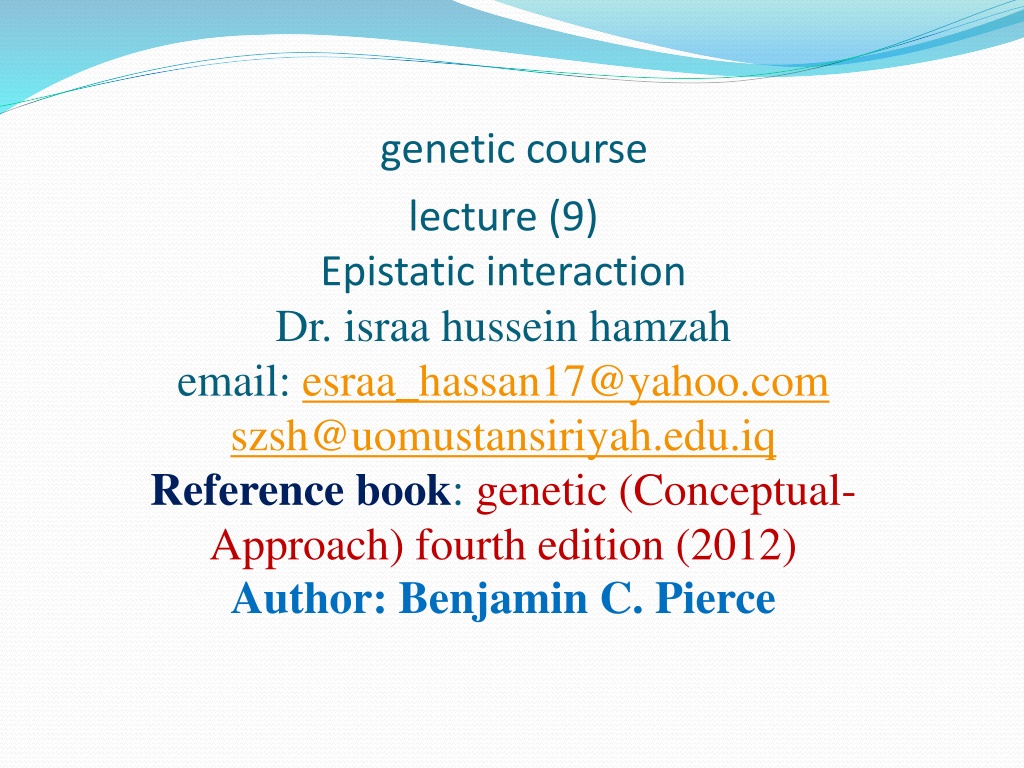







![Halal_Chicken_from_Brazil-_Ensuring_Quality_and_Authenticity[1]](/thumb/86918/halal-chicken-from-brazil-ensuring-quality-and-authenticity-1.jpg)
